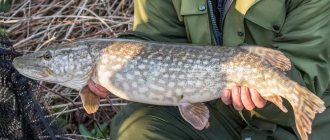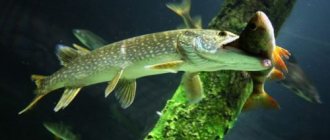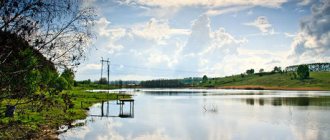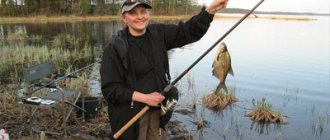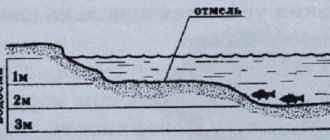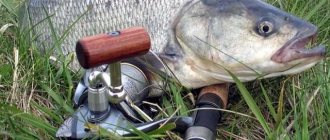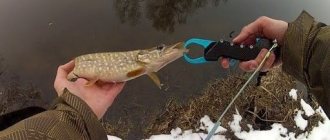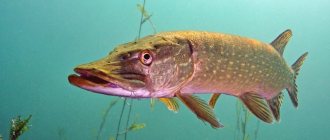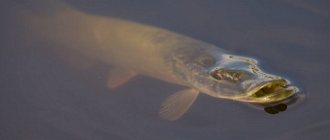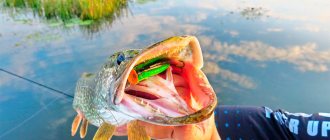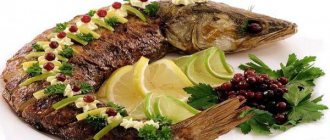How does pike behave in March?
With the appearance of the first thawed patches, the pike rushes to get enough oxygen, and, hungry for food, rushes to the bait. Where the first thawed patches appear, you can find not just one fish, but schools of hungry fish. In the spring, pike go to spawn, but during this period you can catch a male; in addition, in different regions of Russia you can observe the following pattern: first large fish go to spawn, then medium-sized ones, and finally small ones. In some places, pike of all sizes spawn at the same time. Before the onset of spawning, pike tries to gain strength, so during this period it can be found in different places in the reservoir.
Pike fishing in March - we fish with a spinning rod from the shore
At these moments, with the beginning of the appearance of the first coastal gullies at the confluence of small rivers, the most active coastal fishing for pike begins in March. Using a spinning rod with a fast action and a length of 3.00 meters or more, you can successfully fish the entire expanse of water that has opened up to this moment.
Moreover, sometimes, with small gullies, the predator stands under the edge of the ice, using it like summer grass cornices.
By throwing jig baits or heavy spoons onto the ice and pulling them off it into the water, you can achieve spectacular pike bites immediately after the bait falls into the water.
And already, already in March, you can actively use heavy small sinking wobblers to fish small ice-free areas of water.
Is it possible to catch pike in March?
According to the new rules, in most regions of Russia the ban on pike fishing is in effect from January 15 to February 28, therefore you can fish in March. However, fishing rules tend to change, so it would be a good idea to first clarify the information for your region.
For Belarus, on the contrary, the ban is valid from March 1 to March 31, and local fishermen are forced to miss the pike bite in early March.
More about zhora
The exact time of the zhora depends on the place of fishing (reservoir), weather conditions and time of day, as well as water temperature. Observations by fishermen show that spawning occurs most quickly in small bodies of water with a weak current or its complete absence, at a depth of 1.5-3.5 meters. Why at shallow depths? – in such places the water warms up very quickly. As for large rivers, due to the abundant flow and impressive size, the water warms up very slowly. In order not to miss this “golden” time, it is recommended to remember the period of active pike biting in early spring every year. That is, entries in a fishing notebook would be appropriate.
Where to look for pike in March
Let's consider options for finding pike depending on the type of reservoir.
On the river
Enterprises (state district power plants, reservoirs) discharge excess water into rivers, and the riverbed, which is not yet completely free of ice, is filled with water. This is the period when fish are hungry - you can go out on a boat along the water-filled riverbed with a spinning rod.
On the small river
Shallow rivers are winding, with a narrow channel. Even if the ice has melted, it is better to fish on such rivers from the shore. Small and medium-sized predators accumulate in reeds, creeks, and snags - stay in these places, and you are guaranteed a catch.
On the lake
In spring, on a lake 4-8 meters deep at a temperature of +4 degrees, the ice melts along the edge of the shore. You should catch pike in such reservoirs from the ice (don’t forget about safety - spring ice is very fragile). Pike easily covers the distance from the depths to the shore in search of air and food.
On the pond
Ponds up to 4 meters deep quickly warm up in the sun. The fish in such ponds quickly leave for spawning, that is, earlier than their counterparts in the lake or river. The spawning of a pike in a pond will begin earlier than that of a predator living in a river or lake.
Pike behavior in spring in March
When the first ice begins to melt, the oxygen level in the water begins to decrease. The pike is truly activated for the first time since the deep winter. Pike begin to eat 2 weeks before spawning, and 5-12 days after spawning.
Features of spawning:
- Occurs after the ice melts at a temperature of 3-6 degrees .
- During spawning, pike swims to shallow water 0.8-1.2 meters deep.
- An easy logical conclusion can be made that pike are caught before spawning on ice, with jigs and spoons, and after spawning with spinning rods, at a water temperature of 8-10 degrees.
- In the middle zone (for example, on the upper Volga), spawning begins in mid-March and lasts until mid-April.
- In the southern regions (for example, on the Don, in the Krasnodar Territory), spawning can begin at the end of February and end in March.
- Spawning for an individual individual lasts 3-4 days, for the entire population from 3 to 4 weeks.
- Small individuals begin to spawn first, then medium ones, then large ones.
By the way , during spawning, male pike still remain active.
No one can give exact dates for your city and specific reservoirs, but you yourself can determine whether spawning has begun or not.
Signs:
- The pond begins to thaw.
- The air temperature remains stable up to 5 degrees during the day.
- The buds are swelling on the birch trees.
Where to look in March
Which places are considered catchy and cool:
- In coastal areas and shallows. During spawning, pike swim close to the shore to spawn.
- It often stays near aquatic vegetation: bushes, cattails, reeds, snags.
- Pike loves places where one river flows into another.
- Changes in depth, edges.
- In abnormally warm weather, it sits out in pits.
Early spring is good because there are no hot days in the middle of which it is impossible to catch pike. That is, de facto, all days are favorable for pike fishing.
Why doesn't pike bite in March?
March is the ideal time for catching pike; it feels hungry and rushes to almost any bait: wobblers, twisters, spoons, ratlins, cicadas, blanks, and live bait. If you are still left without a catch, it means that some fishing conditions were not met.
Let's consider the optimal conditions for a good catch:
- place for fishing. Small and medium-sized fish live in places overgrown with reeds and algae. Large pike love depth - they are not found in small rivers or small lakes;
- Times of Day. The bite is best 1.5 hours before dawn and closer to sunset;
- weather. Pike prefers cloudy, rainy weather and little wind;
- air temperature. For the spring period, the optimal air temperature for pike fishing is from +8°C to +25°C;
- Atmosphere pressure. Low atmospheric pressure is favorable for pike.
Fishing place
To catch pike in early March, you need to follow one simple rule: you need to look for the predator in shallow water. In this part of the reservoir, the concentration of fry is much higher than at depth, and the water temperature is warmer. Hunting within the coastline is a “balm for the soul” for the predator, which in the dead of winter was almost always in the depths.
If a fisherman catches pike using girders, then it is advisable to arrange the fishing “tools” as follows: every 3-5 meters, a hole is drilled into which the live bait is immersed, after which the bite alarm and flag are placed in the working position.
“Guns” need to be supplied about 7-10 units. If you put more than 10 fishing rods, fishing turns into hard work rather than active recreation. While waiting for a bite, you can keep yourself busy by trolling or catching additional live bait.
To catch pike in March, you need to constantly experiment, experiment and experiment again! We hope that the information will serve as a good help for catching trophy predators not only for beginners, but also for experienced fishermen. No tail, no scales!
Tackle and float for catching pike with live bait.
A very important step in fishing is the choice of gear. Since pike are often very cautious in spring, it is worth taking a closer look at the float tackle.
This tackle is quite silent when casting. For float gear you will need:
- Rod
- fishing line
- Leash
- Float
- Hook
- Sinker.
This tackle is practically no different from float tackle for white fish. Its only difference is the presence of a steel leash.
Such a float will help avoid line breaks. It also gives an additional margin of safety to your gear.
The test rod should be at least 30 grams, and the desired length is five meters. This will be optimal for pike fishing.
You should choose a fishing line with a diameter of at least 0.3, or use a braided fishing line with a smaller diameter of 0.2. The advantage of regular fishing line is that it tends to stretch, thereby absorbing the jerks of the fish.
When choosing a float, you should give preference to heavier ones, as they will work better. A large float will also prevent bait fish from dragging the tackle away from the fishing point. But when a pike bites, the float will perfectly signal the bite.
The big disadvantage of float tackle is that it is quite problematic to catch in the wind. Fishermen love this tackle for its prostate. Even a child can fish with this tackle.
Fishing tactics
When there is a sufficient amount of live bait in the bucket or cane, you can begin the exciting stage of catching pike. First of all, it is important to properly place the bait on the hook. In order not to damage the vital organs of small fish, fishermen most often use two mounting options: attaching it by the lip, or pinning it by the dorsal fin. After this, the required fishing depth is set and a smooth cast of the equipment is made. Typically, a horizon within 20-40 cm from the bottom surface is selected for fishing.
All that remains is to monitor the movement of the float and prevent the baitfish from approaching bushes or snags. After the pike bites, there is no need to rush to hook. A characteristic feature of the toothy predator is that it holds the bait in its mouth for some time after the attack. And the hook does not always end up in the predator’s mouth. Therefore, you should wait until the pike pulls the float to the side again. This will be the signal to hook. Once hooked, the fish tries with all its might to free itself. They use sudden head movements, jumping out of the water, and moving in different directions. Often, thanks to active actions, the pike gains the desired freedom. The fisherman needs to try to constantly keep the line tensioned, avoiding sagging. Then the chances of successful fishing will increase significantly. After bringing the fish ashore, you should not fall into euphoria. You need to carefully remove the hook from the toothy mouth. For this, it is useful to have a yawner and an extractor with you. It is best to store prey on a kukan.
Spring fishing for pike with live bait remains the most effective way of fishing. This type of fishing was suggested to man by Mother Nature. Natural bait will always outperform the most modern wobblers, twisters and spinners. It is important to collect reliable gear and find the place where the predator is hiding. Then you will be able to experience all the delights of fighting a large pike.

